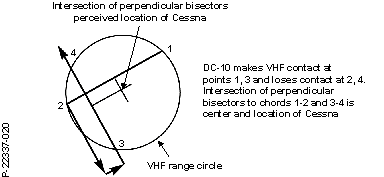From the diagram in the story I would have though that the reception would be lost on the opposite side of the box, not the side it shows the lost aircraft was closest to?
The radio boxing diagram looks OK to me. The DC-10 has already worked out a very rough location from the sun and is flying towards that location, heading South West and maintaining a constant altitude for the exercise. The Cessna is asked to transmit on VHF, let's say, a 2 second burst every 10 seconds.
At Point 1 reception of VHF by the DC-10 begins to increase, from nothing. At Point 2 it decreases to nothing. From this, the Cessna is abeam track 1-2, half way between 1 and 2, but it can be to the North of 1-2, or the South.
The DC-10 then turns left at Point 2 and then does a 180 after which the VHF signal starts to increase from nothing at Point 3. At Point 4 the signal decreases to nothing. From this, the Cessna is abeam track 3-4 and half way between 3 and 4, thus resolving the question, North or South of track 1-2.
Had the Cessna been North of 1-2 then the circle simply shifts North West.

(Note that initial aircraft/aircraft calls would have been by long range HF radio, but no mention is made of this. Note also the comment, 'VHF Aural boxing depends on continuous transmission on VHF otherwise a silence can be construed as loss of contact'. The Cessna would almost certainly have been fitted with ARC VHFs. I wouldn't trust one to provide a continous transmission for that period, it'd burn out and I'll bet the Cessna pilot knew that too. Transmission bursts are more likely.)